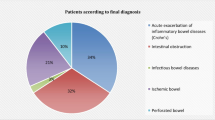Abstract
Purpose
This study was done to evaluate the diagnostic role of enteroclysis with multidetector computed tomography (MDCT) and single-detector CT (SDCT) in patients affected by small-bowel Crohn’s disease.
Materials and methods
Forty-five patients underwent abdominal SDCT (n=20) or 16-row MDCT (n=25) after administration of methylcellulose by nasojejunal tube. Each examination was assessed for small-bowel distension and site and characteristics of the diseased loops. The two CT techniques were then compared. Results were compared with double-contrast enteroclysis performed in all patients and with ileoscopy performed in 28 patients.
Results
In comparison with double-contrast enteroclysis, sensitivity, specificity and diagnostic accuracy were 90%, 71% and 89% for SDCT and 92%, 83% and 90% for MDCT. Ileoscopy confirmed the absence of disease in five patients and the presence of Crohn’s disease in 20. Compared with SDCT, MDCT reduced scanning time and respiratory artefacts and permitted better multiplanar reconstructions.
Conclusions
MDCT is superior to SDCT because it allows a better spatial resolution and improves depiction of the pathological patterns of Crohn’s disease.
Riassunto
Obiettivo
Valutare il ruolo diagnostico dell’enteroclisi-TC multidetettore (TCMD) e singolo detettore (TCSD) in pazienti con morbo di Crohn dell’intestino tenue.
Materiali e metodi
Quarantacinque pazienti sono stati sottoposti ad enteroclisi-TC a singolo detettore (n=20) o multidetettore (n=25) previa somministrazione di metilcellulosa tramite sondino naso-digiunale. Abbiamo valutato grado di distensione delle anse, sede e caratteristiche delle anse patologiche, ed abbiamo messo a confronto le due tecniche. I risultati sono stati confrontati con quelli del clisma del tenue in tutti i pazienti, con l’ileoscopia in 28.
Risultati
Confrontando i dati TC con quelli del clisma del tenue, abbiamo riscontrato valori di sensibilità, specificità ed accuratezza diagnostica rispettivamente del 90%, 71% e 89% con la TCSD e del 92, 83 e 90% con la TCMD. L’ileoscopia ha confermato i reperti di normalità in 5 pazienti e un morbo di Crohn in 20. La TCMD è risultata superiore alla TCSD poiché ha permesso di ottenere una riduzione dei tempi di esecuzione, meno artefatti respiratori e ricostruzione multiplanari di migliore qualità rispetto alla TCSD.
Conclusioni
La TCMD è da preferire alla TCSD per la sua migliore risoluzione spaziale e perché consente una migliore rappresentazione dei segni patologici di malattia di Crohn.
Similar content being viewed by others
References/Bibliografia
Wills JS, Lobis IF, Denstman FJ (1997) Crohn disease: state of the art. Radiology 202:597–610
Walsh DW, Bender GN, Timmons JH (1998) Comparison of Computed Tomography-Enteroclysis and traditional Computed Tomography in the setting of suspected partial small bowel obstruction. Emerg Radiol 5:29–37
Bender GN, Maglinte DD, Kloppel R et al (1999) CT enteroclysis: a superfluous procedure or valuable when investigating small bowel disease? AJR Am J Roentgenol 172:373–378
Herlinger H (1978) A modified technique for the double-contrast small bowel enema. Gastrointestin Radiol 3:201–207
Bender GN, Timmons JH, Williard WC et al (1996) Computed Tomographic enteroclysis: one methodology. Invest Radiol 31:43–49
Klöppel R, Thiele J, Bosse J (1992) The Sellink CT method. Rofo 156:291–292
Scholten ET, Ziedses des Plantes BG, Falke TH (1995) Computed tomography of the large bowel wall. Choice of slice thickness and intraluminal contrast medium. Invest Radiol 30:275–284
Turetschek K, Schober E, Wunderbaldinger P et al (2002) Findings at helical CT-Enteroclysis in symptomatic patients with Crohn disease: correlation with endoscopic and surgical findings. J Comput Assist Tomogr 26:488–492
Rollandi GS, Curone PF, Biscaldi E et al (1999) Spiral CT of the abdomen after distension of small bowel loops with transparent enema in patients with Crohn’s disease. Abdom Imaging 24:544–549
Minordi LM, Vecchioli A, Guidi L et al (2006) Multidetector CT enteroclysis versus barium enteroclysis with methylcellulose in patients with suspected small bowel disease. Eur Radiol 16:1527–1536
Hassan C, Cerro P, Zullo A et al (2003) Computed tomography enteroclysis in comparison with ileoscopy in patients with Crohn’s disease. Int J Colorectal Dis 18:121–125
Wold PB, Fletcher JG, Johnson CD et al (2003) Assessment of small bowel Crohn disease: nonivasive peroral CT enterography compared with other imaging methods and endoscopy-feasibility study. Radiology 229:275–281
Makò EK, Mester AR, Tarajan ZS et al (2000) Enteroclysis and spiral CT examination in diagnosis and evaluation of small bowel Crohn’s disease. Eur J Radiol 35:168–175
Balthazar EJ (2002) Evaluation of the small intestine by computed tomography. In: Gourtsoyiannis NC (ed) Radiological imaging of the small intestine. Springer, Berlin Heidelberg New York, pp 87–130
Horton KM, Eng J, Fishman EK (2000) Normal enhancement of the small bowel: evaluation with spiral CT. J Comput Assist Tomogr 24:67–71
Maglinte DDT, Lappas JC, Heitkamp DE et al (2003) Technical refinements in enteroclysis. Radiol Clin North Am 41:213–229
La Seta F, Buccellato A, Tesè L et al (2006) Multidetector-row CT enteroclysis: indications and clinical applications. Radiol Med 111:141–158
Kelvin FM, Herlinger H (1999) Crohn’s disease. In: Herlinger H, Maglinte DDT, Birnbaun BA (eds) Clinical imaging of the small intestine. Springer, Berlin Heidelberg New York, pp 259–289
Horton KM, Fishman EK (2003) The current status of multidetector row CT and three-dimensional imaging of the small bowel. Radiol Clin North Am 41:199–212
Di Mizio R, Rollandi GA, Bellomi M et al (2006) Multidetector-row helical CT enteroclysis. Radiol Med 111:1–10
Raptopoulos V, Schwatz RK, McNicholas MMJ et al (1997) Multiplanar helical CT enterography in patients with Crohn’s disease. AJR Am J Roentgenol 169:1545–1550
Romano S, De Lutio E, Rollandi GA et al (2005) Multidetector computed tomography enteroclysis (MDCT-E) with neutral enteral and IV contrast enhancement in tumor detection. Eur Radiol 15:1178–1183
Author information
Authors and Affiliations
Corresponding author
Rights and permissions
About this article
Cite this article
Minordi, L.M., Vecchioli, A., Poloni, G. et al. CT enteroclysis: Multidetector technique (MDCT) versus single-detector technique (SDCT) in patients with suspected small-bowel Crohn’s disease. Radiol med 112, 1188–1200 (2007). https://doi.org/10.1007/s11547-007-0215-8
Received:
Accepted:
Published:
Issue Date:
DOI: https://doi.org/10.1007/s11547-007-0215-8




